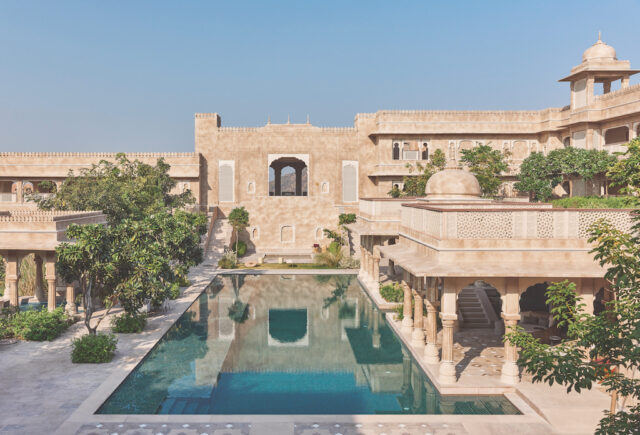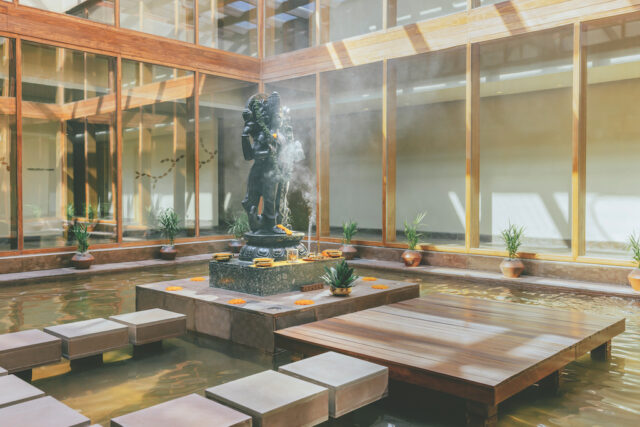
By Ray Rogers
“Take a dip!” cheered our jovial guide, Deepak, as I submerged in the cool, clear rushing waters of the holy Ganges river. Four ceremonial dunks underwater with chants of “Jai Ganga Maiya” (meaning “Praise to the Mother Ganges”) after each, and I had absolved myself of my sins, or so Hindus who gather from all over India believe. I felt exhilarated, a lightness of being as I floated through the streets of Rishikesh after, passing women in a rainbow of brightly colored saris, and sidestepping “holy cow shit,” as Deepak would call out repeatedly, from the sacred cows who ambled along the riverbanks. Deepak was our guide from Six Senses Vana. He’d taken scores of guests on this Rishikesh excursion over the years, and we were the first who actually wanted to get into the river for the ceremonial cleansing, he noted. Inspired, he also put on his swim trunks and followed suit. It’s an experience I couldn’t imagine missing out on.
There’s magic to be found around every corner in India, if you’re willing to participate. We meditated in small shallow caves on the banks of the Ganges, hiked along the awe-inspiring foothills of the Himalayas and made a new friend in a tenacious monkey who hitched a ride on our car windshield en route to the abandoned Beatles ashram.
India is a place I’ve returned to over the years for milestone celebrations (basking in the awesome wonder of the monumental Taj Mahal on my 50th) and Ashtanga yoga studies in the southern Indian city Mysuru. This time, I came on a mission: seeking wellness, nature and healing for a friend who I sensed needed some heart-opening after her husband of 45 years passed away. That the trip came wrapped in a cloak of luxury courtesy of two Six Senses properties was just a bonus.
Our first stop: Six Senses Vana, a 21-acre oasis of calm, quiet healing, right in the heart of bustling Dehradun. While each Six Senses property has an element of wellness and sustainability, Vana has been LEED-certified platinum since 2015, and in October 2024 was certified to be 100 percent in compliance with GSTC, Global Sustainable Tourism Council. It is squarely focused on health and positioned as it is in the foothills of the Himalayas, offers a unique combination of Ayurvedic and Tibetan therapies that you won’t find in many other places. My welcome treatment was a calming traditional Tibetan oil massage called ku nye, utilizing hot stones and acupressure along the meridians—a soothing balm after the overnight flight to Delhi and 5 1/2-hour drive to Vana.
I managed to pack in what felt like a few weeks’ worth of activities during my six-day stay. Excellent daily 7AM yoga was followed by doctor consults and visits with acupuncturists and Tibetan and Ayurvedic healers. I had always wanted to try the in-water shiatsu-based treatment called Watsu, wherein a practitioner cradles your body, moving you around a warm pool as if you were a baby in the womb. It felt gentle and reassuring—and brought unexpected tears of gratitude for my own mom. My travel companion raved about the clarity she felt after a 45-minute meditation with her eyes trained on an open flame as the group chanted “Om” the entire class.
The communal dining at Anayu (which roughly translates as “nourishment/food for life” in Sanskrit)—where traditional Indian thalis are tailored to your specific dosha, or energetic constitution—and at the indoor/outdoor restaurant Salana gave a chance to convene with other guests, each sporting the white pajamas that come freshly laundered to one’s room daily. Around the dinner table, we broke house-made gluten-free bread with an interior designer from Sag Harber, an Upper East Side mother of Indian heritage who came to Vana with her parents, and a pair of doctors from Boston, all enjoying curries, pastas and salads so fresh and flavorful you forgot it was healthy. Much of the produce is grown on-site or sourced from local farmers. (Vana takes pride in partnering with and supporting local communities.) I wholeheartedly feasted here, and still left several pounds lighter.
There was quiet alone time to stroll the exquisite grounds and listen to birds sing or watch families of monkeys swing from trees. One of my most cherished moments came in the early evening chill after a full day of healing therapies and vigorous physical activities (including HIIT circuit training with a private instructor). Sitting on a swing, a soft shawl over my shoulders for warmth, while gazing upon a bodhi tree, I thought about Buddha finding enlightenment. I’ve got a long way to get there, but this felt just about as close to nirvana as I’d yet experienced.
Some of the most impactful experiences happened off-campus. At the start of the week, I took a hike high up in the hilltown of Mussoorie, forest bathing at the Benog Wildlife Sanctuary with the snow-capped Himalayas in the near distance. It was just my guide Deepak—a knowledgeable young man who grew up in the area—and me hiking to a deserted temple, passing by barking deer, black-faced monkeys and the tell-tale sign of the elusive leopards who roam these hills: droppings with quail bones sticking out, remnants of the previous night’s meal. We sat and silently meditated on the mountaintop, to the chanting of the Gayatri mantra: “Om Bhur Bhuva Swaha,” a prayer to the divine light and wisdom guiding people toward enlightenment. “It’s not just about getting to the top,” said Deepak. “It’s about connecting guests with nature. There is an energy in nature, like the Buddha found enlightenment under the bodhi tree.”
The wellness journey ended with our excursion to nearby Rishikesh, with a front-row seat to the daily Aarti prayer ceremony along the riverbank. A cadre of Hindu priests in burgundy and yellow garb conducted an awe-inspiring choreographed evening, brandishing gold serpent-shaped incense holders aflame while singing prayers to a rapt audience.
Afterward, Deepak had something special in store. He recalled me telling him earlier in the week about my friend’s husband’s passing and had arranged a private prayer ceremony to honor the loss. After chanting with the priest, we were each given a plate full of flowers surrounding a lit candle. We placed them in the water, and watched them float downstream, an offering to the holy river for his safe passage.

Six Senses Fort Barwara
Next stop, Rajasthan. After a quick flight to Jaipur, we headed on to Six Senses Fort Barwara, passing fields of vibrant yellow mustard plant flowers, for a few days of pampering and wildlife. The property alone is worth the trip: a fabulous 14th-century fort that’s been meticulously turned into a luxury palace, with a gorgeous pool in the courtyard (evening laps in the moonlight felt like a spiritual experience), and rooms that were fit for a king and queen. Ours had an outdoor shower built right into the suite’s bathroom, and a patio off the living room with a swinging sofa—a perfect spot for a siesta.
One afternoon, we climbed 650 steps to the Chauth Mata temple just behind the property, where a local family was celebrating wedding nuptials. The little kids sheepishly asked for selfies with the two American visitors—which led to the teens and eventually the parents and grandparents wanting in on the action. Within minutes we were invited to dance with the wedding party, and happily jumped in, much to everyone’s delight. I had the distinct feeling it was a moment we would all be talking about for years to come.
The main draw, however, was 30 minutes off-premises: a tiger safari in Ranthambore National Park. We’d been advised that we might not even see a tiger, so maybe not to bother. Fort Barwara’s general manager encouraged otherwise, and organized a last-minute private jeep journey, during which we saw not just one, but five of the magnificent beasts: a 6-year-old male known as Charger, one of the two females in his harem, Riddhi, and the pair’s three cubs. There was one wow after the next on this entire journey, but watching Charger gallantly stride along the dirt road mere feet in front of our open-air vehicle was a majestic crowning to our magical time in India. sixsenses.com



